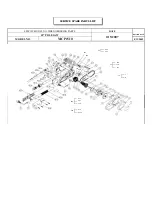
POWE30040
EN
Copyright © 2017 VARO
P a g e
|
10
www.varo.com
Place the material to be cut onto a flat surface such as a workbench, table or floor. Use a
piece of scrap material underneath if:
You do not wish to damage the work surface.
The work surface is likely to damage the blade. E.g. a concrete floor.
Plug into mains supply.
Grasp the tool firmly (See
“
Holding & switching ON/OFF
”
section) and rest its metal
base plate onto the surface to be cut. Ensure that the rear half of the base plate
overhangs the work surface. Do not plunge the blade into the material.
Switch on the tool and wait for a moment for the blade to run up to speed. Next, depress
the safety lock button (3) and plunge the blade into the material slowly and gently, but
firmly. Then push the tool forwards along the line to be cut. If necessary, switch on the
laser generator (1).
NOTE:
Never draw the tool backwards.
Very little force should be used to feed the tool along the cut. Excess force will cause
operator fatigue and excessive wear to the blade and tool. Excess force is also likely to
cause the temperature cut-out to trip, resulting in delays.
Ensure that the base plate is always held flat on the material being cut. This is particularly
important at the start or finish of a cut or if thin strips are being cut where the base plate is
not fully supported.
Once the cut has been finished, lift the tool from the work surface before switching off. If a
lot of dust has been created, keep switched on for a few seconds extra to allow the dust to
clear from within the tool.
12 CUT-OUTS
Plunge cutting may not be possible in some hard materials.
Choose a suitable saw blade for hard materials and change to it. Set the depth of cut (See
“Setting the Cutting Depth” section), plug in the mains supply and then place the metal
base plate (16) onto the work surface. Ensure that the front indication mark on the base
plate aligns with the start line (See
“Line Following” section).
Switch on the tool and wait for a moment for the blade to run up to speed. Next, plunge
the blade into the material slowly and gently, but firmly. Then push the tool forwards along
the line to be cut. (Never draw the tool backwards)
Once the finish line has been reached, lift the tool from the work surface before switching
off. If a lot of dust has been created, keep switched on for a few seconds extra to allow the
dust to clear from within the tool.
Cutting out tips:
If the cut is to be covered, for example by a vent cover, the corners can be overlapped to
ensure that the waste material is completely detached.
If the cut out is to be seen, do not overlap the corners. In this circumstance, as the cutting
blade is circular, the waste material will not be fully detached. The corners will therefore,
require finishing with a knife. If the material is thin and the back surface unimportant, the
waste material can just be pushed out.
Where there is access to the back surface of the material to be cut, the cut out can be
marked out with an over cutting allowance. The cut is then made from the back surface to
ensure perfect corners on the front surface.
































